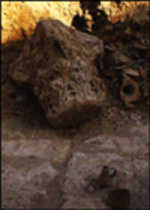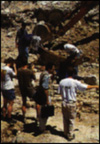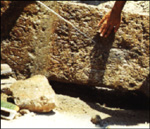
| |


 The successive removal of urban occupation layers opened windows into the more remote past of this quarter
of the old city of Beirut. Recycled Roman columns, and broken pots and lamps from Roman and Greek times had
already appeared in Islamic levels, having been churned up during later settlement
activities. Undisturbed, Graeco- Roman levels produced lovely decorated lamps, bottles for
perfumed oil, and a lamp handle with a Iyre-playing winged Eros, son of the Goddess of
Love, Aphrodite (see p.2), providing evidence for the activities of Beirut's inhabitants of that time.
The successive removal of urban occupation layers opened windows into the more remote past of this quarter
of the old city of Beirut. Recycled Roman columns, and broken pots and lamps from Roman and Greek times had
already appeared in Islamic levels, having been churned up during later settlement
activities. Undisturbed, Graeco- Roman levels produced lovely decorated lamps, bottles for
perfumed oil, and a lamp handle with a Iyre-playing winged Eros, son of the Goddess of
Love, Aphrodite (see p.2), providing evidence for the activities of Beirut's inhabitants of that time.
Roman period walls appeared lower down belonging to houses and shops of a time when a predecessor of today's Weygand Street already functioned as the main east-west thoroughfare of the city. A pedestal dedicated to Julia Domna, the Syrian-born wife of the North African emperor Septimius Severus, had also been recycled as building material. The empress is addressed as 'Mother of the Camps'.
| |
 al@mashriq 960118/960118 |
 Very detailed excavations of an area close to the ribat
of Ibn 'Iraq have revealed vital information about the
diet and environment of Beirut's inhabitants during
Hellenistic and Roman times: fish, birds, livestock,
eggs, fruit, nuts, vegetables and pulses.
Very detailed excavations of an area close to the ribat
of Ibn 'Iraq have revealed vital information about the
diet and environment of Beirut's inhabitants during
Hellenistic and Roman times: fish, birds, livestock,
eggs, fruit, nuts, vegetables and pulses.